
Library Notes // Foraged Flavor
I was lucky enough to have the opportunity to see Tama Wong speak last week and I learned enough to realize how much more there is to learn. Tama is the author of Foraged Flavor: Finding Fabulous Ingredients in your Backyard or Farmer’s Market, the forager for Daniel and incredibly knowledgeable. Her book is fantastic, co written with Eddy Leroux, the chef de cuisine at Daniel, the book is part field guide and part cookbook. It is also available in the library!
By Sara Medlicott,
ICC Librarian
Tama opened her talk with the concept of stewardship and how important that is for foragers. There is a huge spectrum from abundant to endangered plants and it’s important that foragers understand what they are picking and what will happen to the plant population.
Tama focuses her foraging on plants which are not declining or indigenous, but for those of us who are not as knowledgeable as she; each ingredient listed in her book is classified into categories based on availability. Red category plants should be planted and picked only in your garden; they are specialist and conservative native plants. Yellow category can be harvested on a limited basis; they are considered generalist native plants. Green category plants are safe to forage without limits; they are naturalized and invasive plants.
We have a plant problem. Almost all landscapes in the mid Atlantic are being taken over by “green category” invasive plants. Most of this didn’t happen through a natural ecological process – they were largely brought over from Europe and Asia. All of this is creating a monoculture. If we can adapt our expectations and forage responsibly, this can contribute to minimizing the problem.
Unfortunately, diners and chefs have come to expect certain types of trendy wild foods, so those populations are declining. One example is ramps. It is such a common menu item, I was shocked to hear from Tama that they are a specialized indigenous plant which takes 7 years to mature – yes, 7 years! In fact, in Montreal they are completely endangered and the harvesting of ramps has been banned. While Daniel no longer serves them and Tama advises strongly against it, she said a more responsible way to harvest them is to trim just the tops of ramps and not pull out the bulbs.

All of which comes back to managing expectations of consistency and access. If we can learn to eat with the ecosystem, we will be able to solve some of these plant problems and if Foraged Flavor is any indication, the food will still be satisfying and nourishing. An example Tama gave was that people have come to expect ramps in the spring, but what we can eat every year should and will change. The expectation needs to evolve into something wild and delicious and it’s our responsibility from a culinary perspective to introduce diners to new ways of eating.
If you’d like to know more about Tama Wong, check out her TedTalk.
To read further about foraging and wild plants, stop by the library! Here are a few recommended books from Tama and myself:
- Foraged Flavor: Finding Fabulous Ingredients in your Backyard or Farmer’s Market by Tama Matsuoka Wong with Eddy Leroux
- Eating on the Wild Side by Jo Robinson
- The Mushroom Hunters by Langdon Cook
- Foraging and Feasting by Dina Falconi
- The Wild Table by Connie Green

This blog post was originally published by the International Culinary Center (ICC), founded as The French Culinary Institute (FCI). In 2020, ICE and ICC came together on one strong and dynamic national platform at ICE's campuses in New York City and Los Angeles. Explore your culinary education where the legacy lives on.



Add new comment